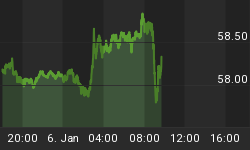A reader asked me about 'Bond Vigilantes' after reading this article: 'Bond Vigilantes' are Saddled Up and Ready to Push Rates Higher.
- There's reason to be concerned about bond vigilantes, who are no longer under "lock and key" and are free to push yields higher, Ed Yardeni told CNBC.
- Yardeni coined the term "bond vigilantes" in the 1980s to refer to investors who sell their holdings in an effort to enforce fiscal discipline.
- People are looking more at the domestic situation and saying, 'You know what, maybe we need a higher bond yield,'" Yardeni says.
This is complete silliness. There are no "Bond Vigilantes".
Fundamentally, there is no way to dump holdings to enforce "fiscal discipline" because someone has to hold every bond issued until it comes to term.
However, there is a record speculative building up against bonds in the futures market.
Hedge Funds Push Record Bets Shorting Treasuries
Bloomberg reports Hedge Funds' Biggest Short in Bonds Faces Make-or-Break Moment.
Hedge funds and other large speculators are more convinced than ever that the 2018 bond-market rout will resume in the days ahead.
The group, known for trading on momentum, boosted short bets in 10-year Treasury futures to a record 939,351 contracts, according to Commodity Futures Trading Commission data through Feb. 6. That means the violent market moves on Feb. 5, when the Dow Jones Industrial Average suffered an unprecedented drop and 10-year yields fell almost 14 basis points, weren’t enough to dissuade wagers that rates are headed higher. The next gut-check comes Wednesday, with the latest read on consumer prices.
Speculators’ positioning matters because it can push momentum to extremes, and can serve as a contrarian indicator since these traders are among the quickest to switch directions when prices turn against them. By contrast, longer-term holders like asset managers are seen as more likely to stay the course. Their net long in 10-year futures is the highest since October 2015.
30-Year Long Bond Positioning
The chart from COTbase is not to scale. Moreover, the bars represent the price of the bond, not the yield on a 30-year bond.
However, we can see, that when it comes to shorting 30-year treasuries, small speculators display terrible timing. They are positioned for another beating if the yield on 30-year treasures declines.
10-Year Note Positioning

Small speculators have been short the 10-year note since the beginning of last year. They are now almost as net short as the big speculators. Bloomberg cites a record short position. Bloomberg may be counting options.
The top half of the chart is from CotPriceCharts. Those small and large spec bars are to scale. I overlaid a chart of yield for the same time frame.
There is also free COT data at FreeCOTData but it does not separate out small from big specs.
COT Data Releases
Generally, the data in the COT Reports is from Tuesday and released Friday. The CFTC receives the data from the reporting firms on Wednesday morning and then corrects and verifies the data for release by Friday afternoon.These reports have a futures only report and a combined futures and options report.
The charting services take the data and produce charts, some of them free.
A key point to remember is you are always looking at stale data. In volatile weeks positions can change rapidly. The data released on February 9, for February 2, is very suspect. We get a new report on February 16.
Another VIX-Like Opportunity
Speculators have been adding leverage, getting shorter and shorter as yields increase. This is a recipe for disaster at turns.
Let's not confuse increasing speculation with 'bond vigilante' myth.
The widespread beliefs that the Trump tax cuts will fuel investment and inflation will rise because of wages are both half-baked at best. For now, as long as traders are on the right side of things, it doesn't really matter why.
One reason yields have been rising is the opposite of what people think. For discussion, please see Trapped Funds Myth: Foreign Cash Repatriation Boom in Reverse.
By Mike "Mish" Shedlock

















